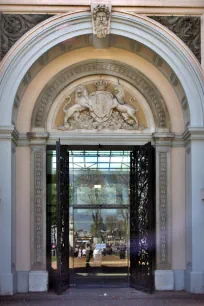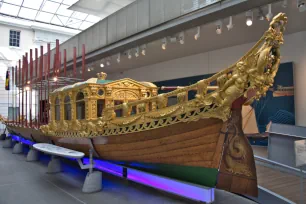The National Maritime Museum illustrates the historical relationship between the British and the sea. The museum has an extensive collection of items ranging from paintings, ship models and uniforms to actual vessels.

The holdings of the museum are spread across three premises in Greenwich. The main building of the museum occupies the west wing of the Royal Naval Asylum, a former school for orphaned children. Many of the marine paintings of the museum are on display in the Queen’s House and other nautical objects can be found in the Royal Observatory.
History
The origins of the museum go back to 1823 when the National Gallery of Naval Art opened in the Painted Hall of the Old Royal Naval College. A collection of three hundred paintings and nautical objects were displayed in the magnificent hall. In 1934 the collection was transferred to the newly founded National Maritime Museum, which opened its doors three years later in the nearby Queen’s House.
The Queen’s House still holds a collection of maritime paintings, but the bulk of the content of the National Maritime Museum is now housed in a separate building that was constructed in the nineteenth century as an expansion for the Royal Naval Asylum. The museum underwent a significant modernization in 1999 and in 2011 it opened a new wing with a more modern and spacious entrance.
The Museum



The National Maritime Museum boasts a collection of over two million items; a selection of this vast collection is spread over three floors, arranged around a glass covered courtyard.
Ground Floor
Entering the museum from the new south entrance brings visitors to the gallery “Voyagers: Britons and the Sea”, which, through a number of objects and an audio-visual installation introduces visitors to the special relation between the island nation and the sea. One of the galleries in the main wing pays tribute to explorers, from the Vikings to British explorers, many of whom lost their lives. A room in the middle of the museum’s main hall shows that working on the ships in the arctic waters during the Second World War was equally fraught with peril. An adjoining room focuses on the maritime history of London from 1700 to today.
Some of the museum’s largest objects are displayed in the main hall between the galleries. Amongst them are a number of vessels and a colorful collection of wooden figureheads that once decorated ships’ bows. But the main highlight is the nineteen meter (62 ft) long royal barge, made in 1732 for Prince Frederick, the oldest son of George II. The gilded barge is elaborately decorated with carved figures and ornaments that symbolized Britain’s status as a sea power.
First Floor
A huge world map painted on the floor of the main hall is a new attraction for the youngest visitors, who can sit on miniature boats and follow the trails of explorers. A touch-enabled tablet gives visitors more info and real-time data while they walk across the map.

The galleries focus on the trade routes to the corners of the British Empire, from the New World to Asia. It also highlights less pleasant aspects of maritime history, such as slavery.
A must-see in the museum are the magnificent 1920 stained-glass memorial windows from the Baltic Exchange Building. The building, which was home to a maritime trading market, was bombed by terrorists in 1992, but the windows were saved from the rubble. The striking Gherkin now occupies the former site of the Baltic Exchange.
Second Floor

The top floor has several attractions geared toward children. Young children will enjoy exploring the ‘Seahorse’, a ship in the Children’s Gallery, while older children can try to navigate a ship in the Ship Simulator.
The museum also displays an excellent collection of model ships from 1660 to 1815 including a large wooden model of the Royal William, a warship from 1719 with one hundred guns.
Finally, a gallery of the museum is devoted to Britain’s most famous naval hero, Admiral Horatio Nelson. You can see the jacket Nelson wore in 1805 during the Battle of Trafalgar, where he was fatally wounded. You can clearly see the bullet-hole in the jacket.

